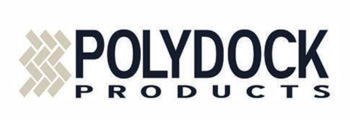Jan 5, 2021
Boat Lift Styles
In Wisconsin waters, there are (5) different boat lift styles generally used. The (5) styles include:
- Cantilever,
- Vertical,
- Hydraulic,
- Floating, and
- Elevator boat lifts.
Different conditions require different boat lifts.
Cantilever Lift
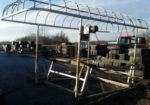
Cantilever Boat Lift Style
If you are on an inland lake or river where the water depth does not fluctuate more than 12″ throughout the boating season and wave action does not exceed 6″, a cantilever lift is generally suitable for you.
Cantilever lifts requires about 12″ of water plus the draft of your boat to operate. The lifting rack requires that depth of water due to the shape of the frames.
At first glance, that seems deep enough for most boats, but you still have to allow enough water above the rack to float your boat.
The real limitation of a cantilever lift is the total lifting height. If a river rises, especially after a heavy rainstorm, a boat can easily float off the lift. The boat is not up high enough to prevent the water from washing it away. Who knows how far it will travel before it hits something?
The normal lifting range is between 40″ and 48″. Remember, the rack starts at 12″ plus the draft of your boat, so you are usually less than 12″ above the water at its highest point.
Vertical Lift
On any large body of water, a vertical lift is the recommended lift for most people. Vertical lifts do a better job of protecting your boat from waves.
Some vertical lifts require about 6″-10″ of water plus the draft of the boat. As an example, ShoreMaster vertical boat lifts require only 6″ of water (plus the draft of your boat). Given the same conditions, you have already gained 6″ with this one feature alone.
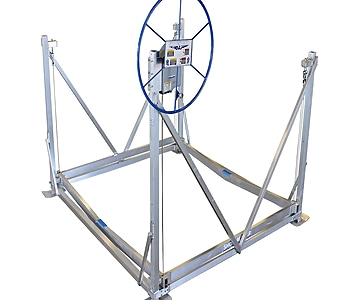
Vertical Boat Lift Style
Now, add the total lifting height of 66″ for a ShoreMaster vertical lift, and you gained a minimum of 18 or more inches of protection vs. a cantilever lift.
Your most significant protection comes from the lifting height. Don’t forget about the strength of the lift frame and the gauge of the material used. ONLY the ShoreMaster boat lift has welded side frames with heavy-duty square or rectangular frames for more strength.
Other brands require several packages of bolts and nuts to assemble the frames. Eventually, the holes for the bolts enlarge, and the frames begin to sway. The solid welded frame is a real advantage at this time. A minimal number of bolts are needed.
Can a lift raise a boat TOO high?
Strange as it may seem, it is possible to go too high. How? When the frames are not strong enough to handle the leverage of the weight from the boat.
At least one brand does lift higher than a ShoreMaster lift, but they failed to use welded frames for the additional strength it needs.
If you can imagine the forces acting against the frames in a storm when you have thousands of pounds suspended in the air with only simple bolts to hold them together. The higher the boat is, the greater the leverage on the frames.
Their leg wall thickness is not heavy enough to handle the forces acting against it. Green Bay produces more than 4′ high waves, and the waves frequently strike against the bottom of a boat, adding to the leverage problems.
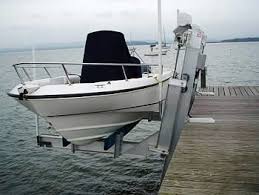
Elevator Boat Lift Style
Elevator Lift
Used with permanent pier installations, Elevator Lifts are a great combination. They raise the boat from the side, making access to the lift very easy.
Narrow channels and areas experiencing large fluctuations in water depth or hurricanes require elevator lifts.
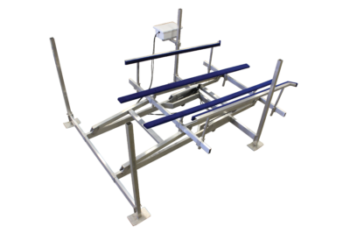
Hydraulic Boat Lifts Style
Hydraulic Boat Lift
A hydraulic lift generally lifts the highest – up to 6′ high in some cases. This height, along with the wide stance of the base, gives excellent protection for your boat. The hydraulic lift handles high waves and water surges during storms also.
These D.C. operated units are:
- Quiet:
- Smooth operating;
- Solar-powered;
- Wireless remote-controlled (There are no wheels to contend with.)
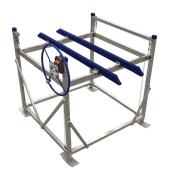
Vertical PWC Boat Lift
Vertical PWC Lift
Jet Ski lifts come in 3 styles: Vertical, Cantilever, and Floating.
The vertical PWC lifts allow you to get into shallow water and raise your boat higher than the cantilever type. They operate in the same fashion as a standard vertical boat lift and provide more protection for your PWC.
The PWC cantilever lift works fine on small lakes and rivers that do not fluctuate in depth or have high waves.
SHOREPORT
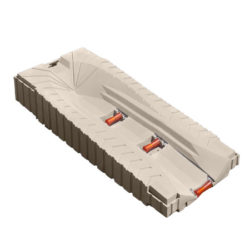
ShorePort PWC Boat Lift Style
The floating lifts (ShorePort) are excellent on rivers that fluctuate a lot in depth or inland lakes. These are very simple to use and require very little water to operate. The floating lift has no maintenance and you simply drive up onto the floating unit. No wheel cranking involved.
Wave action above 12” is not recommended for this type of “lift”. Combine a floating dock with the PWC floating lift and you have the perfect combination for a lake or river that fluctuates during the season but does not have large wave action.
Caution – when using any PWC lift – If you have a sand or small rock bottom near the shore use caution when approaching the lift. Sand and small stones can be sucked into the intake and destroy your motor.
For more information see also: www.wisconsinpws.com/boat-lift-size-correct-one/ and https://wisconsinpws.com/boat-lift-selection/
Where is Pier & Waterfront Solutions?
Located at 7325 St. Hwy 57, it’s 3 miles south of Sturgeon Bay and 1 mile PAST the intersection of Cty MM (heading north). Look on the right at the intersection of Idlewild Road and Hwy 57.
ARE WE OPEN?
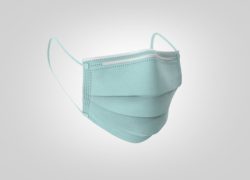
Please use face masks
Pier & Waterfront Solutions remains “open” year-round.
The virus continues to spread. PWS is conducting as much business as possible by email, text, or phone.
Site visits continue as usual. When in-person contacts are necessary, we follow “social distancing” guidelines as closely as possible.
Our display yard is OPEN 24-7
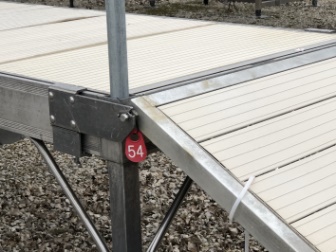
Red Tag
PWS‘s display yard is always open for you to examine at your leisure. All displays available for sale have a numbered, red tag on them. If you want more information or pricing, please reference that number when you inquire.
We provide estimates and quotes by email to make the process faster, safer, and paperless.
What can YOU do?
Please conduct as much business as possible via emails, messaging, and phones. When you see our staff and crews on-site, please practice “social distancing.”
Call, message, or email us with any questions.
Thank you for allowing us to work with you safely.
Let’s all stay safe!
Dec 2, 2020
Jerry,
Keri and Alex were both great – very helpful and friendly. A good experience! Thank You!
Hope you have a wonderful Thanksgiving and a good and healthy holiday season and winter!
Susan L. Baileys Harbor, Door County
Oct 6, 2020
How to Winterize Your Boat
Whether you like it or not, Summer is over.
The boating season has come to a close.
Our crews are nearing the end of the removal season also. That’s a sure sign that the season has ended.
Here are tips to winterize your boat and prevent significant problems in Spring.
Can you really do it yourself?
If your boat needs significant maintenance, now might be the time to have the work done. Some service providers offer preventative maintenance as part of their winterization work.
Why not schedule it now? You’re not using the boat anyway! You’ll get out on the water quicker in Spring. It’s better than if you try to get the work done in the spring when shops are busy.
Winterizing your boat by hiring a professional is always a great idea, but it can be an expensive one.
However, if you take it slow, and maybe enlist the assistance of a boating buddy or a willing teenager, you shouldn’t have a problem- (willing means a bribable teenager.)
You know your boat better than anyone. Use your best judgment about your boat needs. You could also refer to your boat owner’s manual. Sorry guys – some people actually do read those.
For example, are alcohol-based types of antifreeze okay to use on your boat? Your manual can answer that question.
What do I need to Winterize my Boat?
Start by making time to work on your boat.
Next, make sure you have the necessary items to get everything done. (Here’s where reading your manual comes in, guys). You’ll need products like antifreeze, fuel stabilizer, and fogging oil.
Here are some of the top products you’ll need to complete the winterization job.
- Fuel Stabilizer — Gasoline decomposes over time. Deposits form over time in your fuel tank. A fuel stabilizer, such as STA-BIL, keeps the fuel fresh and prevents buildup while stored over the winter. Using this, you won’t have to drain the fuel tank, and your boat will start up nice and easy in the spring. Don’t be afraid to add extra stabilizers.
- Marine Antifreeze — Like the water in your car engine, antifreeze is required to protect your boat’s engine and other components. Unlike a car, you want to use only a marine antifreeze.
Why Use Marine Antifreeze?
Boats have a circulation system that uses water from the lake. It pumps the water through the engine block before discharging it back into the lake.
Automotive antifreeze is very toxic and should never be returned to the lake. Protect both the marine system and the environment.
As an alternative, RV antifreeze tends to have similar properties and can be a good choice.
Choose an antifreeze made with propylene glycol because it’s non-toxic and biodegradable.
What else should I have available?
- Fogging Oil — There are many steel and iron parts in a boat motor. Fogging oil lubricates these internal parts and repels moisture to prevent rust. Follow the directions on the container.
- Marine Vinyl Protectant — Cold weather can dry out vinyl deck seats and chairs quicker than you might think. Meguiar’s Marine/RV Vinyl and Rubber Cleaner (Amazon) will keep your vinyl deck furniture from drying out and cracking over the winter.
- Marine Lubricant — Look into a product like Overton’s Marine Penetrating Lubricant to stop rust and repel moisture.
How to Winterize Boat Motors
Now to the actual winterizing.
The motor is the single most important and most expensive part of your boat. Outboard motors easily run over $10,000.
You want to ensure the motor was winterized to eliminate the need for repairs or purchase a new engine, both of which are extremely expensive.
While the general concept is the same, there are a few differences in winterizing inboard, outboard, and I/O (sterndrive) motors. Don’t forget about those jet-skis.
How to Winterize Outboard Motors
- Add a fuel stabilizer, like Sta-Bil, to the gas tank to prevent the valves and motor from “gumming up.” No one wants to hear an engine turning over repeatedly with no sign of life.
- Flush the water tank with fresh water. Then drain the tank.
- Flush the motor with marine antifreeze and fog the engine with fogging oil.
- Be sure to store the engine in the vertical position, so if any water remains, or somehow gets inside over the winter, it will drain away.
- Lubricate grease fittings.
- Remove the propeller and grease the prop shaft.
Winterizing an Inboard or I/O (Sterndrive) Motors
Inboard and inboard/outboard (a.k.a. sterndrive) motors require the same primary winterizing process.
Proper winterization is crucial for this type of engine to prevent the water from freezing and cracking the block.
- Put STA-BIL in the fuel tank.
- Start the engine and get it up to temperature.
- Flush with marine antifreeze and fog with fogging oil.
- Change the oil and the filter.
- Remove water drain plugs in the exhaust manifold and the engine block if available for extra protection.
- If there are no plugs on the block or exhaust, remove the thermostat to flush with antifreeze. Replace the thermostat when done.
Winterizing Jet ski Motors
Did you think we forgot? While they don’t have a propeller or a traditional motor, jet-skis and jet boats still require winterization.
- Put STA-BIL in the gas tank and fill the tank.
- Flush with marine antifreeze. You’ll need a pump, as jet-driven engines don’t have a water pump of their own.
- Change the oil if it’s a four-stroke.
- Fog the engine.
- Take out the battery and store it inside over the winter.
Winterize the Fuel Tank of the Boat
Gasoline contains a small amount of water. Therefore, it’s vital to winterize the fuel tank. Even a tiny amount of water can freeze and cause damage to your boat’s fuel tank.
Even if it doesn’t freeze, the water will sink to the bottom of the tank and sit there waiting to run through the engine in Spring.
There’s a debate on whether it’s best to fill the tank to the top or leave it empty. If you use a good fuel stabilizer, it should be sufficient to leave gas in your tank.
- Change fuel filters.
- Fill with fuel and add a fuel stabilizer like STA-BIL.
- Change the water separators, if equipped.
Did you Winterize the Bilge of your Boat?
Here are a few winterizing tips:
- Clean the bilge with soap and water.
- Spray with a moisture-displacing lubricant.
- Use antifreeze to prevent water from freezing. (Remember our tip above)
Winterizing the Cover and Accessories of a Boat
Boat covers need a little love too. One storm could pull the cover right off your boat, or, at the very least, rip and tear it.
To avoid this, make sure that it’s intact and robust enough to withstand strong winds. Choose a heavy canvas cover that’s water-resistant and large enough to cover the waterline of the boat.
A better option is shrink wrapping. Shrinkwrapping, customarily done at a marina or boat storage yard, is the better choice but can get expensive.
Here are a few tips for the traditional canvas cover:
- Use insect and rodent repellent to steer clear of spiders, bees, mice, and other troublesome creatures. You don’t want to pull that cover off next spring and find a swarm of bees.
- Secure padding on sharp corners, such as around windshields, to prevent wearing through the cover.
- Make sure that there are no “dips” in the cover where rain or snow can accumulate.
- While you’re on deck, give the vinyl chairs and seats a good going over with vinyl cleaner. Remove cushions over the winter.
It may seem like a lot of work to get your boat ready for winter, but the time and care you take now will ensure that it stays cold-weather safe and prepared to go in the spring.
Sep 1, 2020
What’s new in boat lift winches? Updated
The Whisper winch from ShoreMaster was a significant improvement over other boat lift brand winches in 2018. ShoreMaster continues to be the leader in the Marine industry.
Most boaters were annoyed by the clanking noise generated when they turned the large wheel on their boat lift. That noise disappeared after the introduction of the Whisper winch in 2018.
Then, in 2019, they introduced another refinement – the Whisper Winch II.
This new winch gave you extended cable life by introducing a more substantial diameter drum. Why is this important? Having a 50% increase in winch diameter means there is less internal stress on the cable strands as they wrap around the drum.
The larger drum diameter, in turn, reduced internal chafing in the cable significantly. An added advantage is the galvanizing on the winch cable strands lasts longer.
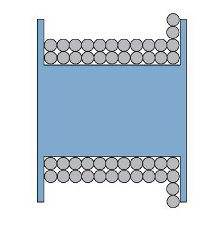
Typical Cable Stacking
What is cable stacking?
Today, there has been another improvement. The winch drum now has grooves cut into it to guide the cable smoothly around the drum. Cable “stacking” is virtually eliminated.
Without cable “stacking,” the life expectancy of the cable increases. It also means fewer cable “shocks” and abrasion. By “shocks,” we are not referring to an electrical shock.
When a cable begins to stack up along the edges of the drum, it will climb two or more levels. At that point, the cable will slip off the stack, and the boat falls about 1/4 to ½” in an instant. The “falling” results in a thunderous noise which “shocks” the person operating the winch. That doesn’t seem like much movement, but that 1/4″ – ½” can mean a broken cable if it is weak.
The “shock” is dangerous for the cable if the cable is in a weakened state. The cable is free to move, and then all the weight of the falling boat is suddenly applied.
Picture a moving car hitting an immovable object. The “shock” is similar to hitting an unmovable object with a moving one-ton object.
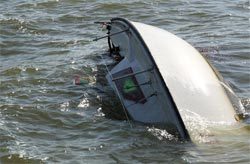
My boat lift cable broke…and I can’t get ….
One moment the boat is free to fall (albeit a short distance), and in the next moment, it snaps to a complete halt. All the pressure is on the cable at that point. Any weaknesses in the cable (rust, broken strands, frayed wires) could mean your boat will end up in the water and not necessarily floating.
With further testing, they realized that the main lifting cable could be changed back to stainless steel on the larger boat lifts. Now, ALL of the cables are stainless steel again.
BUT THAT’S NOT ALL!
There is still one more advantage to the Whisper winch II. In the past, two bolts mounted the winch to the leg post. The bolts meant that if you added a canopy later, the winch must be entirely removed.
Today, the winch clamps in a sleeve that fits snugly around the leg. There is a significant reduction of install time as a result. The clamp also ensures the winch is correctly installed. It can not be misaligned. Misalignment of the winch was easy to do with the winch bolted to the leg. These same bolts contributed to cable stacking also.
In Conclusion
The continued introduction fo these refinements keeps Shoremaster at the top of the best-in-class list.
Tell Your Friends & Family
Have friends or neighbors you believe should see this article? Email a link to this article – and Thank you!
You can visit Pier & Waterfront Solutions on Facebook also.
Don’t Forget – PWS is the expert when you have a waterfront problem!
Where is Pier & Waterfront Solutions?
Located at 7325 St. Hwy 57, we are about 3 miles south of Sturgeon Bay, and 1 mile past the intersection of Cty MM (heading north). Look for the intersection of Idlewild Road and Hwy 57.
ARE WE OPEN?
Pier & Waterfront Solutions has remained “open.”
While all this is going on, we are working to maintain the trusted service you expect. That’s important to us.
We are conducting as much business as possible by email, text, or phone. Site visits will continue as usual. When in-person contacts are necessary, we follow “social distancing” guidelines as closely as possible.
Call, message, or use this simple request form to get answers and quotes.
Thank you for allowing us to work with you – safely.
Let’s all stay safe!
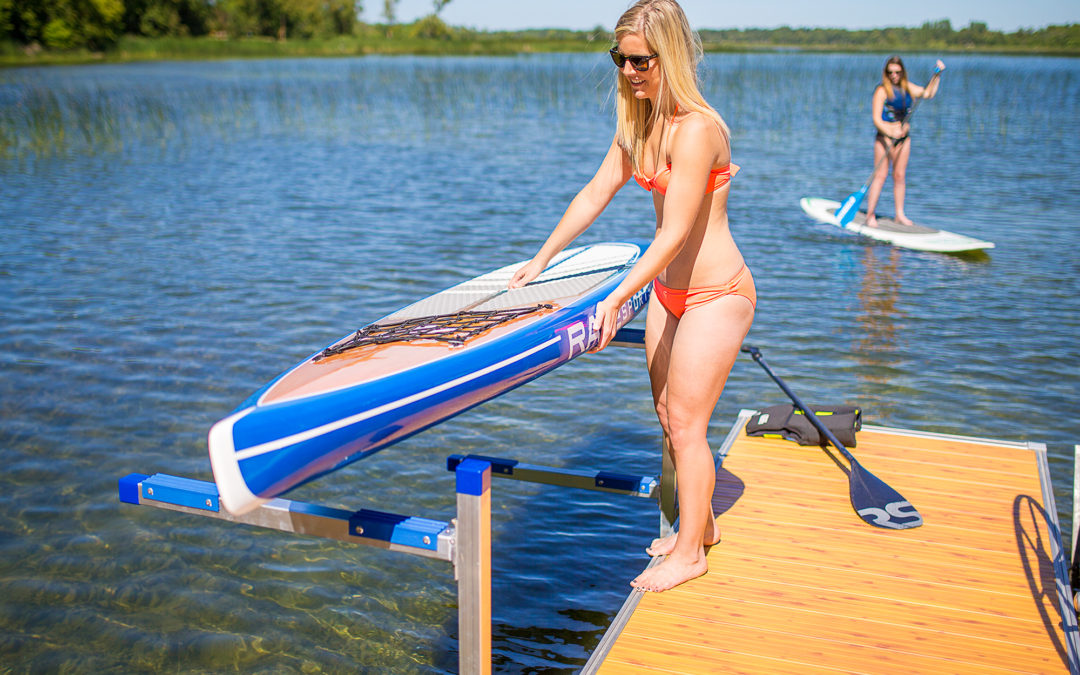
Apr 14, 2020
PADDLEBOARDS
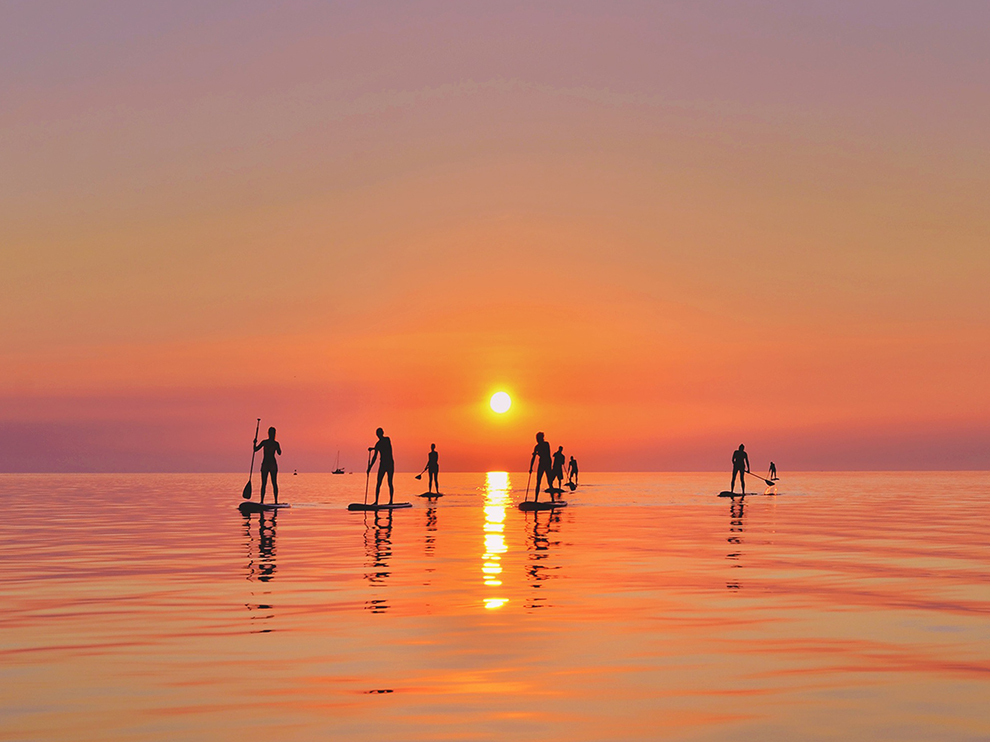
Paddleboarding at sunset.
Paddleboards have become a popular sport in Door County. It’s a great stress reliever, and it helps develop upper body strength, balance, and agility. Another benefit – you can “social distance” at the same time.
It’s a complete body workout. It’s a great way to experience the peace and tranquility of the Door County Peninsula.
Imagine the beautiful sunrises and sunsets you can enjoy on Green Bay.
What Happens When You Return to your Pier?
When you return to your pier, is it cumbersome to carry your paddleboard to your house or garage each time? Don’t like taking it over the rocks on the shoreline? Don’t want to risk falling or twisting your ankle?
Do you want an easy way to store your paddleboard? Wouldn’t it be better to store it right on your pier securely?
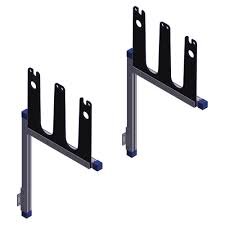
Paddleboard Rack
Why not get a paddleboard rack from Pier & Waterfront Solutions?
This convenient rack mounts to your ShoreMaster dock or the new PWS
3-Season pier with ease. (The mountings adapt to other brands too).
It’s simple to use. Place your paddleboard in the slots, secure it and forget it.
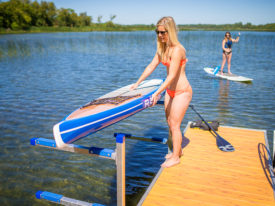
Alternate Paddleboard Rack
The storage rack fits all solid paddleboards. It makes a convenient and attractive addition to your pier.
Do you have an inflatable paddleboard? Here’s an alternate model.
Either way, your board will be ready to go in an instant.
Pier & Waterfront Solutions has a complete display for your convenience. Stop in to see it today!
Call Jerry @ 920-493-4404 for more details or to place an order. Enjoy all the activities that the Door County peninsula has to offer.
Need more information about paddleboards?
Tell Your Friends & Family
Have friends or neighbors you believe should see this article? Email them this link – and Thank you!
Where is Pier & Waterfront Solutions?
Located at 7325 St. Hwy 57, it’s 3 miles south of Sturgeon Bay, and 1 mile past the intersection of Cty MM (heading north). Look on the right side, one mile north, at the next intersection (Idlewild Road and Hwy 57).
ARE WE OPEN?
During this time of uncertainty, Pier & Waterfront Solutions is staying “open.” We have implemented measures to ensure the safety of our employees and visitors. At the same time, we are working to maintain the trusted service that you have come to expect.
We are implementing these precautionary measures:
1. Conducting as much business as possible by email, text, or phone.
2. Site visits will continue but with limited in-person meetings. When in-person contacts are necessary, we will follow “social distancing” guidelines.
3. Our display yard is always open for you to examine at your leisure. All displays have a numbered, red tag on them. If you want more information or pricing, please reference that number.
Is there More?
4. Some employees will be working remotely, but they are always available by phone.
5. Any employee with symptoms or illness is sent home.
6. We continue to provide estimates and invoices by email to make the process paperless.
7. Crew starting times are being staggered to limit social interactions.
8. We keep the same crews together to limit cross interactions.
With these measures, we hope everyone will stay safe, and we will be back to normal operations soon.
What can you do to help us?
1. Please conduct as much business as possible via emails, messaging, and emails. This step protects everyone involved.
2. When you see our crews installing equipment, please practice “social distancing.”
Thank you for allowing us to work with you.
So – YES – ARE WE OPEN?
Please call, message, or email us with any questions.
Let’s all stay safe!
Contact:
Jerry @ (920) 493-4404 or Jerry@wisconsinpws.com – Commercial work & new/used Sales.
Dave @ (920) 905-2588 or Dave@wisconsinpws.com – Erosion control & shoreline work.
John @ (920) 493-4405 or John@wisconsinpws.com – Scheduling & Service work

















